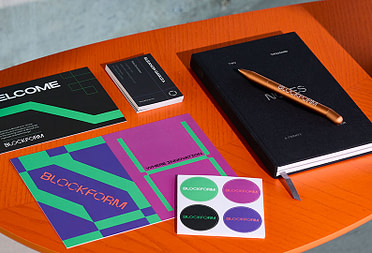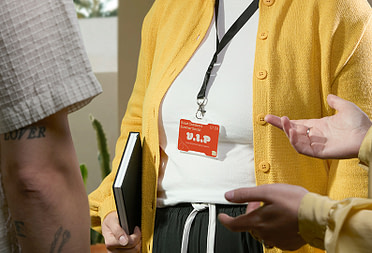The ultimate guide to designing with type
From font size to type leading, tracking and kerning, we’ve got you covered.

If you’re new to designing with type, or just want to brush up with some helpful tips to elevate your aesthetic, we’ve got you covered.
When it comes to questions on type, who better to ask than graphic designers? We sat down with MOO’s creative team to demystify the jargon and get some helpful tips on making your designs look their best.
What’s the difference between type, typeface and font?
The terminology around fonts is complex, with the words font and typeface often being used interchangeably. In a nutshell, here’s what the main typography terms mean:
Typeface
The typeface is also known as a “font family”. This is the term for the unique design of individual type – e.g Helvetica.
Font
The font is the weight and size of a typeface. For example, Helvetica Light Oblique and Helvetica Bold all belong to the Helvetica typeface as they carry the same inherent design.
Type
Type is the encompassing typography term for all fonts and typefaces.
So, now we’ve covered the basics, what about designing?
Choosing your font size
How big does my font need to be?
“Your brand’s words can appear in any number of places, from the top of a billboard to the back of a business card,” explains Millie, our Head of Design, “so, the size of the canvas that your letters will sit on will have a big influence on how tall they stand. The type of font you use will also dictate how easily it can be read. Lightweight fonts, like Helvetica Neue UltraLight, would need to be printed larger than a heavier font, such as Franklin Gothic to be legible.”
How to choose the right font size for print
According to MOO’s graphic designer Emily Wheeler, “Your Business Card, Flyer or Postcard should have a minimum font size of 7pt, while printed T&Cs should be no smaller than 6pt.”
How do different typefaces affect font size?
The typeface and font you choose can also have a big impact on how large it should be printed. For example, if you’re designing a wedding invitation, you might choose to use an elaborate, script typeface for the names to create an impact. In this case, you would need to print in a much larger size to make sure it’s legible. Smaller details that need to be easily read, like the venue location and time, could be printed in a cleaner font which can afford to be smaller.
Our designers’ quick font tips
- Clean, simple typefaces can often work better for more corporate businesses, whereas creative or craft businesses can afford to use something more expressive.
- You can also use type as a graphic element. On a business card, for example, larger scale initials can be printed as a background, with smaller contrasting text on top. This creates a dynamic, playful effect.
Designing with descending letters
What are descending letters?
The invisible line that your type sits on is called the baseline. Descending letters are any letters that drop below that baseline – ‘g’, ’y’, ’j’ and ‘p’, for example. Ascending letters, on the other hand, are typefaces that extend above what is known as the ‘x height’, like ‘k’, ’l’, and ‘b’. The ‘x-height’ is the height of lowercase letters without any extensions, such as ‘a’, ’c’, and ‘x’.
Why are they important?
“Descending letters are important to watch out for,” explains graphic designer Em Stokes. “If you’re designing a Flyer, for example, you’ll be including lots of text, so you need to make sure that the ascenders and descenders on each line don’t touch. Otherwise, it can look really untidy and illegible.” To give your lines more personal space, you need to adjust the leading.
What is type leading?
Leading is the gap between two baselines in lines of text. When the type leading between baselines is too narrow, the descender (the ‘tail’ of a ‘j’ or a ‘g’) overlaps the letters below.
Can different typefaces affect descending letters?
There’s no standard spacing when it comes to typography. Each typeface has a unique design, with some having longer ascenders and descenders than others. More elongated types will naturally need more breathing room.
Our designers’ quick font tips
- Be mindful of the reader – adjust your leading for different typefaces to keep your words legible and clear.
- Get the perfect fit by adjusting your type leading in the character toolbar on your Illustrator and InDesign programs.
What about tracking and kerning?
What is font tracking?
Tracking is the term for the space between letters in a word. If you adjust the font tracking in your design or illustration program, it will adjust, or, “track” the whole word evenly. The problem with this is that with certain types, some letters can appear too close to one neighbour and distant from the other. This is where kerning comes in.
What is font kerning?
Tracking spaces the letters evenly in a word, whereas font kerning is the technique of manually altering the spacing of individual letters. This is helpful for sometimes tricky letters like ‘r’.
Creating effects with tracking
“Tracking isn’t necessarily just a practical technique,” says Phil, MOO’s senior graphic designer. “It can also be used for stylistic effect. If you were designing the headline for a Flyer, you could use tracking to space out the letters for impact, make it easier to read, and attract attention.” If you have a more modern, clean aesthetic to your branding, naturally narrower typefaces can be spaced out to reflect that.
Our designers’ quick font tips
- Always track first – you can kern if you need to once the letters are spaced.
- Only change the tracking and kerning for a specific purpose, as most typefaces have been optimised on programs such as Adobe Illustrator and InDesign.
- Font tracking is usually only applied when words have been capitalised.
Ready to start designing with type? Print your new creations on Business Cards, Flyers and Postcards.
Keep in touch
Get design inspiration, business tips and special offers straight to your inbox with our MOOsletter, out every two weeks.






